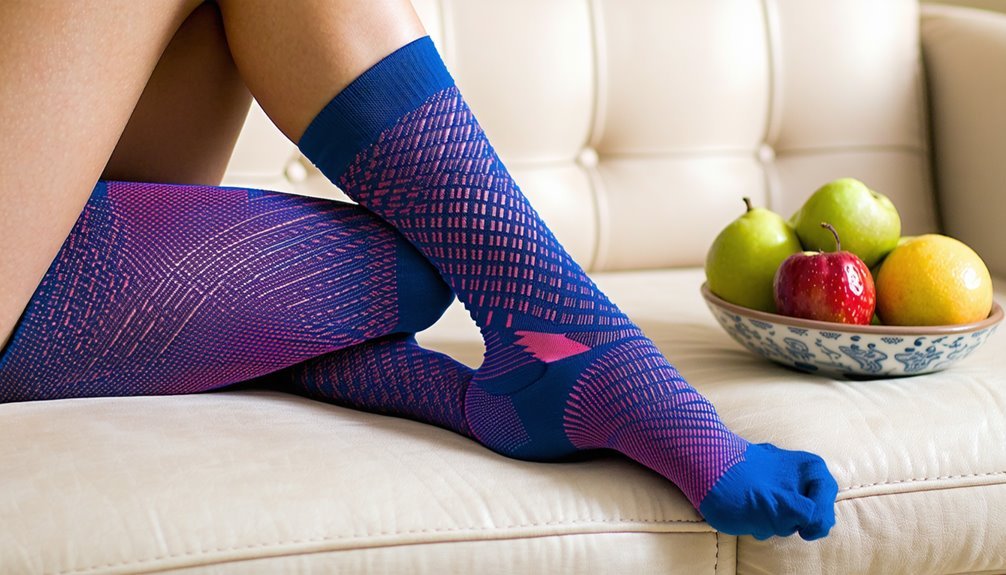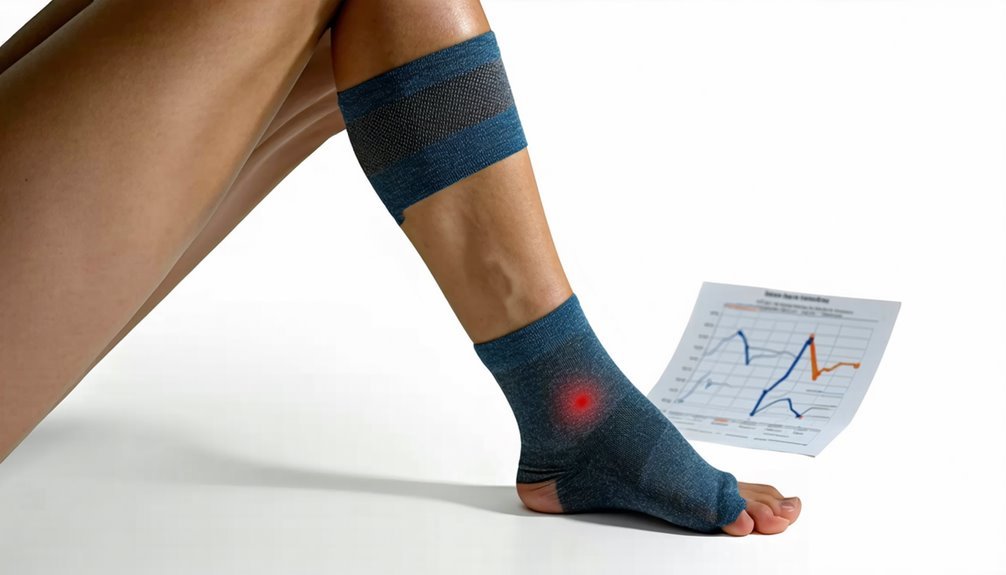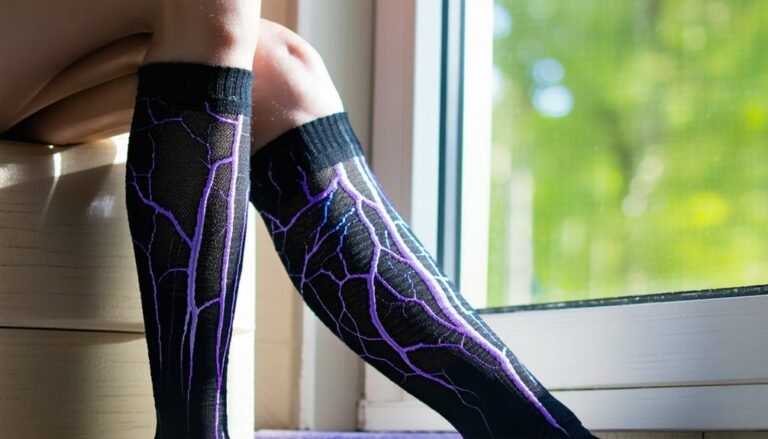Can Compression Socks Cause Swelling?
Compression socks can cause swelling if they're the wrong size or not used correctly. A poor fit might restrict circulation, leading to increased swelling and discomfort. It's essential to follow accurate sizing guidelines and consult a healthcare professional to guarantee the socks apply the correct pressure gradient. Always monitor for signs like pain or numbness, which indicate improper use. Understanding the complexities of compression socks guarantees you maximize their benefits effectively. Consider gaining deeper insights next.
Understanding Compression Socks and Their Purpose

While compression socks might seem like a simple piece of clothing, they serve an essential purpose in managing venous and lymphatic health. You're probably aware that these socks are designed to apply pressure to your lower extremities, enhancing circulation and reducing swelling. When considering compression sock types, it's vital to understand the various compression levels available. Graduated compression socks offer different pressures, measured in millimeters of mercury (mmHg), providing higher pressure at the ankle that decreases up the leg. This design helps prevent blood pooling and supports venous return. Choosing the appropriate compression level depends on your specific medical condition, and it's wise to consult with a healthcare professional to guarantee you're selecting the safest, most effective option for your needs.
How Compression Socks Work on the Body
Compression socks, with their strategic design, are not just about providing comfort; they play a significant role in enhancing physiological functions. By applying graduated compression, these socks improve circulation mechanics, facilitating venous return from the lower extremities to the heart. The varying compression levels exert pressure that decreases from the ankle upwards, which aids in reducing venous pressure and potentially prevents swelling.
Here's a simple breakdown:
| Compression Level | Description | Purpose |
|---|---|---|
| Mild | 8-15 mmHg | Light support and minor swelling |
| Moderate | 15-20 mmHg | Varicose veins, mild edema |
| Firm | 20-30 mmHg | Moderate edema, post-surgery |
| Extra Firm | 30-40 mmHg | Severe edema, chronic venous issues |
| Medical Grade | 40-50 mmHg | Severe conditions, always under supervision |
Understanding these levels guarantees you select the right support for maximum safety and efficacy.
Common Benefits of Using Compression Socks
When you incorporate compression socks into your routine, you may experience improved venous return, leading to enhanced blood circulation and decreased leg edema. This can contribute to reduced leg fatigue, allowing you to maintain activity levels with less discomfort. Additionally, these socks support enhanced muscle recovery by minimizing vibrations and providing consistent pressure on the lower extremities.
Improved Blood Circulation
Although often overlooked, enhancing blood circulation is a fundamental benefit of using compression socks. By applying gentle, graduated pressure to your legs, these socks facilitate improved blood flow, which is essential for efficient oxygen delivery to your muscles and tissues. This mechanism can help reduce the risk of venous disorders and promote vascular health.
Scientific evidence supports that compression socks can effectively improve hemodynamics, thereby optimizing your circulatory system's function. As the pressure is strongest at the ankle and gradually decreases up the leg, it's designed to combat venous stasis and enhance venous return to the heart. By wearing compression socks, you're taking a proactive step in maintaining your vascular health, ensuring your blood circulates efficiently and safely throughout your body.
Reduced Leg Fatigue
Leg fatigue, a common discomfort experienced by many, can be greatly alleviated by the use of compression socks. These specially designed garments apply graduated pressure to your legs, promoting effective blood flow and facilitating fatigue reduction. By enhancing circulation, compression socks support oxygen delivery to muscles, vital for reducing tiredness and aiding leg recovery.
Wearing them during activities or prolonged standing can mitigate strain on your lower limbs, reducing the risk of overexertion. Evidence supports that consistent use of compression socks can lessen the sensation of heaviness and aching often associated with leg fatigue. Prioritizing safety, these socks are a non-invasive intervention, offering a straightforward approach to improving daily comfort and overall leg health without compromising your well-being.
Enhanced Muscle Recovery
Recovery is a essential aspect of muscle health, and compression socks greatly enhance this process. By applying consistent pressure, these socks improve venous return, which facilitates the removal of metabolic waste products from muscle tissue. This mechanism is significant for muscle recovery, particularly after intense exercise. Research indicates that wearing compression socks post-exercise can reduce muscle soreness and decrease recovery time, allowing you to return to physical activities more quickly. The post-exercise benefits are not only about speedier recovery but also about enhancing muscle repair and reducing inflammation, ensuring your safety during subsequent workouts. When you prioritize muscle recovery with compression socks, you're actively supporting your body's natural healing processes, enabling safer and more effective physical performance over time.
Potential Risks and Misconceptions

While compression socks are often hailed for their benefits in reducing swelling and improving circulation, it is vital to recognize the potential risks and misconceptions associated with their use. Misunderstood benefits can lead some individuals to overuse these garments, believing more compression is always better. This misunderstanding may result in adverse effects, such as skin irritation or discomfort due to improper fitting or material sensitivity. You should be aware that not all compression levels are suitable for everyone; personalized medical advice guarantees safety and efficacy. It's also essential to dispel the misconception that compression socks are a universal solution. They aren't a substitute for medical evaluation if you're experiencing unexplained swelling. Always prioritize consulting a healthcare professional to avoid potential complications.
Factors That May Lead to Swelling
Swelling, medically known as edema, can arise from a variety of underlying conditions, so understanding these factors is critical for effective management. Swelling causes include medical conditions like heart failure, kidney disease, and venous insufficiency. However, it's important to take into account lifestyle factors as well. Prolonged sitting or standing can compromise blood flow, leading to fluid accumulation. High-sodium diets, often overlooked, can exacerbate fluid retention, worsening edema. Inactivity and obesity may also contribute, as excess weight puts additional pressure on veins, hindering circulation. For safety, regularly monitor symptoms and consult healthcare professionals to identify specific causes. By recognizing these factors, you'll empower yourself to address underlying issues effectively and maintain ideal health while using compression socks.
Importance of Proper Fit and Sizing
Ensuring the correct fit and size of compression socks is essential for their effectiveness in managing swelling. You should use accurate measurements and adhere to sizing charts to prevent excessive tightness, which can impede circulation and worsen symptoms. By prioritizing proper fit, you'll enhance the therapeutic benefits and comfort of your compression therapy.
Accurate Measurements Matter
Although many factors contribute to the effectiveness of compression socks, proper fit and sizing are paramount in managing swelling effectively. Accurate measurements guarantee that the compression level is appropriate, preventing exacerbation of symptoms. Utilizing precise measurement techniques, such as measuring the circumference of your ankle, calf, and sometimes thigh, is essential. Consistency in sizing accuracy assures that compression socks apply the intended pressure gradient, promoting venous return and reducing fluid retention. An ill-fitting pair may compromise therapeutic outcomes and potentially lead to discomfort or increased swelling. As a result, when selecting compression socks, prioritize acquiring accurate measurements from a healthcare professional or using validated guidelines. This patient-centered approach emphasizes safety and guarantees you receive the best benefits from your compression therapy.
Avoiding Tightness Issues
Proper fit and sizing are not just about comfort; they're critical in preventing tightness issues with compression socks. If your socks are too tight, they can impede circulation, leading to the very swelling you're trying to prevent. To guarantee effective tightness prevention, prioritize proper sock selection. Begin by considering your specific medical needs and consult a healthcare professional for guidance.
Compression socks vary in pressure levels and materials, so it's crucial to choose socks that meet your individual requirements. When selecting, focus on the sock's elasticity and compression gradient. Remember, a well-fitted sock should provide gentle, consistent pressure without causing discomfort or leaving marks on your skin. Prioritize precision in your sock selection to enhance both safety and efficacy in managing your health.
Sizing Charts Importance
Accurate sizing charts play a pivotal role in guaranteeing compression socks fit correctly, which is essential for their effectiveness. Misfitting socks can lead to suboptimal compression, potentially causing discomfort or even swelling. You should adhere to sizing guidelines to determine the appropriate sock size, guaranteeing you benefit from the therapeutic effects. Measuring techniques are vital, involving precise measurements of your ankle, calf, and leg length. This evidence-based approach guarantees the compression gradient is applied correctly, promoting venous return and reducing edema risk. It's important to remember that a proper fit not only enhances safety but also maximizes the socks' therapeutic potential. By following these guidelines, you're taking proactive steps to safeguard your health and well-being.
Underlying Health Conditions to Consider

When considering the use of compression socks for swelling, it is vital to acknowledge any underlying health conditions that might influence their effectiveness. If you have venous insufficiency, compression socks can help improve circulation and reduce chronic swelling. However, heart conditions, such as congestive heart failure, might require careful evaluation, as improper compression could exacerbate symptoms. Lymphatic disorders, which impair fluid drainage, may necessitate specialized compression garments rather than standard socks. Additionally, diabetes complications affecting circulation and sensation in your feet should be addressed with caution to prevent adverse effects. Consulting with a healthcare provider guarantees that compression socks are appropriate for your specific condition and that they won't inadvertently cause harm. Prioritizing safety and effectiveness is essential in managing these health concerns.
Recognizing Signs of Improper Use
While evaluating underlying health conditions is important, it's equally essential to be vigilant about recognizing signs of improper use of compression socks. Improper sizing can lead to adverse outcomes, including increased swelling or discomfort. If the socks are too tight, they may impair circulation rather than aid it, potentially exacerbating your condition. Conversely, loose-fitting socks may not provide the therapeutic pressure needed. Monitoring symptoms is vital; be attentive to persistent pain, numbness, or changes in skin color. These could indicate that the socks aren't fitting correctly or that they need adjustment. Additionally, pay attention to any new swelling or bruising, as these may be signs of excessive compression. Always prioritize comfort and effectiveness to guarantee safety and ideal results.
Tips for Safe and Effective Use of Compression Socks
For ideal outcomes, guaranteeing the safe and effective use of compression socks is essential. First, understand the various compression sock types available: graduated, anti-embolism, and non-medical support. Each type serves different therapeutic purposes, so selecting the right one is vital. Adhere to usage guidelines by consulting your healthcare provider, who'll recommend the appropriate compression level based on your condition. Typically, socks should be worn throughout the day and removed before bedtime to prevent constriction. Confirm proper fit by measuring your leg circumference and length, as incorrect sizing can lead to adverse effects, including swelling. Regularly inspect your skin for irritation or pressure marks, and replace socks every six months for maximum effectiveness. Prioritize comfort and vigilance in your compression therapy regimen.
Frequently Asked Questions
Can Compression Socks Be Worn During Exercise?
Can you wear compression socks during exercise? The suspense lies in their compression benefits. Yes, evidence shows they enhance exercise performance, improve circulation, and reduce muscle soreness. Prioritize safety by ensuring they fit correctly to avoid potential issues.
Are There Different Types of Compression Socks for Specific Conditions?
Yes, there're various compression socks tailored for specific medical conditions. They offer different compression levels to improve circulation and reduce symptoms. Consulting with a healthcare professional guarantees you choose the safest, most effective option for your needs.
How Do I Wash and Maintain Compression Socks?
Your compression socks are your lifeline! Use gentle washing techniques—hand wash or machine on a delicate cycle. For best maintenance, avoid bleach, air dry, and check fibers regularly. Proper care guarantees they're safe and effective for long-term use.
Can Compression Socks Be Worn Overnight?
You're considering nighttime benefits of wearing compression socks. Evidence suggests they can improve circulation. However, potential risks include skin irritation or restricted blood flow. It's crucial to consult your healthcare provider to guarantee safety and suitability for overnight use.
Do Compression Socks Expire or Lose Effectiveness Over Time?
You might wonder if compression socks lose effectiveness over time. It's true; factors like fabric durability and compression levels degrade. Regular replacements guarantee peak performance, enhancing circulation and assuring your safety. Always prioritize well-maintained, effective compression wear.





